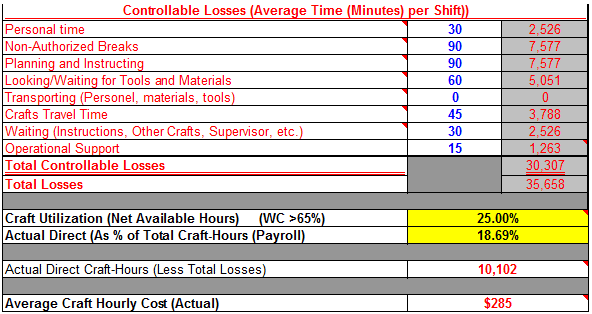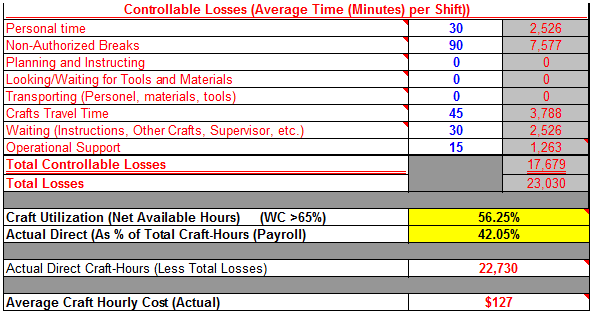Good maintenance planners can have a significant impact on the bottom line, yet many companies don’t pay adequate attention to this role. With 18 percent of a typical maintenance technician’s day spent looking for parts and 24 to 26 percent walking to and from the job site, almost 50 percent of each day can be wasted doing non-value added activity. This article will address the financial impact of maintenance planners on an organization and will provide a clear understanding of how to improve this function and yield better results.
The term “world-class” is thrown around like Scotch Tape, Xerox, and Kleenex. It has lost its true meaning. Many believe that world-class is being the best in what you do and how you do it. When I visited different organizations around the world I used to explain that world-class meant being in the top quartile in your industry but it’s more than that now, I believe. I have discovered working in so many different industries that the best of the best exhibit common fundamental attributes that separate them from the pack regardless of industry and therefore positioning themselves as true world-class organizations. There are eight characteristics that I’ve identified:
- Commitment to safety
- Robust and well-defined training program
- TPM/Operator Care/Autonomous Care program
- Daily cross-functional department meetings
- Root Cause Analysis (RCA) as a team effort
- Well-defined defect elimination process
- Consistent supply chain that incorporates life cycle costing
- Time
Time being the subject of this paper, it amazes me that organizations have time to do things over but never enough time to do it right the first time. There are many factors that contribute to this but maintenance planners play a large role.
What Separates the Best from the Rest?
When it comes to separating typical maintenance practices from those that are considered world-class, there are certain areas that the best organizations excel in. The ability to plan and schedule work that achieves the minimum impact on production or operations is a key factor. The best performing companies migrate to proactive maintenance activities to realize greater than 65 percent preventive maintenance and predictive technology utilization. They establish and consistently achieve a better than 90 percent compliance record.
80 percent or higher in pre-planned work and exceeding 85 percent overall schedule compliance is yet another indication of proactive maintenance. For every hour of effective planning, the typical return is three hours in maintenance activity reduced or an equivalent avoidance in materials and lost production downtime. Planning has the most profound effect on timely and effective execution of maintenance work and resources. A solid maintenance planner has direct impact on these numbers.
What Makes Good Maintenance Planners?
There are certain common qualities among the best maintenance planners. Experience is a must. Typically planners are promoted within the trades to a planning position. They have key skills that will aid them in developing job plans. I would hope it would be intuitive that they read prints as well. Planners must have the capability to become “super users” of their respective Computer Maintenance Management System (CMMS). They need to be very comfortable navigating around the system and be just as comfortable with spreadsheets and word documents. Working well with co-workers is a must. I’ve witnessed some very good planners who were not respected because but they didn’t work well with others. They were reduced to being good clerks. I have never met what I would consider an excellent planner who wasn’t self-motivated. Supervisors or managers should never have to ask a planner what they’re working on. These individuals tend to be the “Get Her Done!” type.
What Do the Numbers Tell Us?
Organizations are in business to make money. There are very few individuals who have any direct impact on the selling price of their products in the open market. That pricing is determined by supply and demand. That’s Economics 101. Yet every individual contributes to the cost of producing that product. That’s called Cost of Goods Sold (COGS). So all things remaining the same, if we reduce the cost of producing our product in theory, our margins or profits increase.
How can a maintenance planner possibly have an impact on the profit or margin of a company? The simple answer is to plan maintenance activities. My definition of maintenance activity is defined as the following:
Successful execution of a planned work order in the safest manner, in the shortest period of time, that is least disruptive to Operations, at optimal cost.
Here are some things to think about:
- The average maintenance operation experiences 30 to 33 percent waste in their budget because of poor maintenance practices
- 18 percent of the typical maintenance technician’s day is looking for tools or parts
- 24 to 26 percent is spent walking to and from the job site
- 63 percent of maintenance activity is self-induced
- Reactive maintenance is three to four times more expensive than planned activity
A good maintenance planner will have well-written job plans with correct sequencing of tasks along with materials, tools, and safety or other special considerations included in work packs. It is not uncommon for maintenance organizations to be functioning at less than 20 percent utilization or “wrench-time”. As stated before, for every hour of effective planning, the typical return is three hours in maintenance activity reduced or an equivalent avoidance in materials and lost production downtime. These costs are directly associated with the cost of producing the product or service. If we can increase the utilization or wrench-time of our maintenance group to restore, rebuild and maintain the assets producing those products and our unscheduled breakdowns decrease then our margins increase correspondingly.
Planned and scheduled work has shown exponential improvements in safety, uncovering hidden capacity, and costs. Look at the following case study assumptions:
- 22 technicians averaging $42.24/hour
- Overtime averages 18 percent with four percent absenteeism and tardiness
- Each person averages three weeks of vacation and five days of sick leave
- Work week is eight hours x five days
- No maintenance planner on staff
- Total available capacity: 45,760 man-hours
We need to take the vacation and sick leave out of our maximum capacity – 3520 hours. We also need to include the average absenteeism – 1830 hours. Our available hours are now 40,410 (12% less than capacity). These are considered uncontrollable loses.
Based on observations, the following are averages for each individual in a typical eight-hour shift. These are considered controllable losses (Figure 1).
 Figure 1. Controllable Losses.
Figure 1. Controllable Losses.
As you can see, out of the 45,760 available hours only 10,102 are actual direct hours. Notice the average hourly cost of our technicians now. Average hourly rate is $42.25 but the actual cost to turn wrenches is $285 per hour. That falls directly to the bottom line. This comes straight from the COGS line and decreases the opportunity to improve margins or profits.
There are two activities that have the potential to increase wrench-time by 50 percent: plan maintenance work and kit planned maintenance work. Let’s look at the numbers after we’ve implemented planning and kitting into the process (Figure 2). The maintenance techs no longer have to plan their own jobs (which brings consistency) and they no longer have to spend time looking for parts or tools because they now are kitted and ready for the planned job.
 Figure 2. Controllable Losses after Planning and Kitting.
Figure 2. Controllable Losses after Planning and Kitting.
The results are staggering. Not only did we increase direct labor by 50 percent, we actually improved it by greater than 100 percent. The average hourly costs were reduced by a whopping 200 percent. That’s the impact that maintenance planners can have on an organization.
Summary
The case study exhibited is an actual organization that made the leap of faith to create a position to plan all maintenance activity. The organization also introduced the kitting process. This resulted in a significant improvement in both the efficiency and effectiveness of maintenance activities. Furthermore, there was a direct improvement to the bottom line and a reduction in production cost.
I consider a good maintenance planner someone who is self-motivated and respected; someone who has the experience and works extremely well with his co-workers. I also strongly recommend that a good planner spends 50 percent of their day on the floor. This time is spent scoping jobs, estimating, gathering information, tools and materials, addressing safety concerns and determining outsourcing or subcontracting needs. They must talk to the operators and lead technicians to help them develop the best possible job plan. A professional maintenance planner is not a clerk. They are an integral part of any world-class organization and are treated as such.
This article was previously published in the Reliable Plant 2013 Conference Proceedings.
By Andy Gager, Life Cycle Engineering